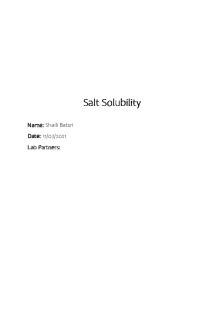Lab Report: Effects Of Temperature On Solubility Of A Salt PDF

| Title | Lab Report: Effects Of Temperature On Solubility Of A Salt |
|---|---|
| Course | General Chemistry 1 |
| Institution | Touro College |
| Pages | 3 |
| File Size | 118.2 KB |
| File Type | |
| Total Downloads | 63 |
| Total Views | 168 |
Summary
Lab...
Description
LAB Report 4/14/16
Effect of Temperature on Solubility of a Salt Introduction The purpose of this experiment is to study the effect of temperature of solubility. Solubility refers to the ability of a given amount of a solute to dissolve in a solvent. Normally the amount of substance that can be dissolved in 100ml of a given solvent is at room temperature (20'C). As the temperature of the water increases, the amount of substance dissolved increases as well, and this is true for all types of substances. Therefore, in this experiment, different quantities of potassium nitrate will be dissolved completely in the same volume of water in four separate test tubes within a beaker at a high temperature. When substances are fully dissolved, each of the test tubes will be needed to cool down and observe the precise solid crystals that will form. The higher the amount of substance in a test tube, the quicker it starts to cool and form crystals, but it does take longer to dissolve beforehand. The solution therefore becomes saturated and contains the maximum amount of solute at that temperature. The data is plotted in the LabQuest, and the graph of the temperature solubility data known as solubility curve, will be obtained. Each data consists a solubility value (g of solute per 100 g H2O) and a corresponding temperature.
Procedure Firstly, we gathered the materials, which included:
LabQuest Temperature Probe Ring stand 4 test tubes Test tube rack Hot Plate 400 ml Beaker 10 ml graduated cylinder Stirring rod Potassium Nitrate, KNO3
After obtaining all the items and wearing goggles and gloves, we labeled the test tubes 1-4. We then measured the amounts of KNO3, which were 2, 4, 6, and 8 grams and 5 ml of distilled water for each tube, respectively. After the next step of connecting the temperature probe to the LabQuest and setting it up, we filled the 400 ml beaker ¾’s full of water. Proceeding, we heated up the water to about 90 degrees Celsius and maintained this temperature. We then inserted the test tube with 2 grams of KNO3 into the water bath and put the temperature probe into the test tube. We used the temperature probe (and the stirring rod at times) to mix the solution within the test tube until the salt dissolved. When the potassium nitrate was completely dissolved, we started data collection and took the tube out of the hot water. Right when the first crystal formed, we tapped keep on the LabQuest. We then repeated this process for the other 3 test tubes. After obtaining all the data, we stopped data collection and disposed of the solutions. Moving on, we examined the data points on the curve and prepared solubilty vs. temperature graph as shown below.
Conclusion As seen in the experiment the solubility of a salt increased in higher temperatures. This occurred because the kinetic energy of the solvent as solute molecules increases the bonds between ions of salts and forces between solute molecules weakens the solute ions and easily fit in between molecules therefore solubility increases. The data shows exactly as expected. All of the test tubes were heated and observed that the larger the amount of substance in the test tube needed the most heating too dissolve completely. In addition to that the opposite also occurred where the least amount of substance need the most cooling to form crystals. The data also showed us that the first test tube with the least substance and the fourth test tube with most substance were under saturated as they fell below the curve and the second and third test tubes were over saturated as they reached over the curve....
Similar Free PDFs

Salt Solubility - Lab Report
- 4 Pages

Exp.1 The Solubility of a Salt
- 7 Pages

Lab solubility curves of a solid
- 2 Pages

Solubility Lab Mini Report
- 5 Pages

Solubility Lab report
- 4 Pages

Lab Report 1 : Solubility
- 4 Pages

Effects of internet on society
- 3 Pages

Effects Of Sitcoms On Teenagers
- 6 Pages
Popular Institutions
- Tinajero National High School - Annex
- Politeknik Caltex Riau
- Yokohama City University
- SGT University
- University of Al-Qadisiyah
- Divine Word College of Vigan
- Techniek College Rotterdam
- Universidade de Santiago
- Universiti Teknologi MARA Cawangan Johor Kampus Pasir Gudang
- Poltekkes Kemenkes Yogyakarta
- Baguio City National High School
- Colegio san marcos
- preparatoria uno
- Centro de Bachillerato Tecnológico Industrial y de Servicios No. 107
- Dalian Maritime University
- Quang Trung Secondary School
- Colegio Tecnológico en Informática
- Corporación Regional de Educación Superior
- Grupo CEDVA
- Dar Al Uloom University
- Centro de Estudios Preuniversitarios de la Universidad Nacional de Ingeniería
- 上智大学
- Aakash International School, Nuna Majara
- San Felipe Neri Catholic School
- Kang Chiao International School - New Taipei City
- Misamis Occidental National High School
- Institución Educativa Escuela Normal Juan Ladrilleros
- Kolehiyo ng Pantukan
- Batanes State College
- Instituto Continental
- Sekolah Menengah Kejuruan Kesehatan Kaltara (Tarakan)
- Colegio de La Inmaculada Concepcion - Cebu







